This post may contain affiliate links. Please read our disclosure policy.
Learn How to Cook Beets using three easy-to-follow methods and enjoy this incredibly versatile vegetable to create colorful, nutritious, and flavorful meals the whole family will enjoy!
Continuing with my series on how to cook all your favorite vegetables, today I have for you guys the beetroot!
If you love vegetables as much as I do, don’t forget to check out these other great posts all about Spaghetti Squash, Sweet Potato, Acorn Squash, and Butternut Squash.
Beets
For a really long time, I had this preconceived and highly imagined image of beets in my brain. Very much unlike the sweet and delicious root that actually are, my brain imaged the poor beet to be tough, crunchy, and most-definitely what it would taste like to land face-first in a pile of dirt.
I hadn’t even tried them, yet somehow, this strange-looking dirt-covered root vegetable (much like a carrot, by the way) was already creeping me out.
Fast-forward ten years and here I am; very well-acquainted with the beet and about to share everything I know, including how to cook beets (3 ways!) with you today!
So, if you’re new to beets, hello!
Despite their rough exterior, they are actually super easy to cook. And, they most definitely do not taste like dirt– raw or cooked.
What are beets?
Beets, otherwise known as beetroots, are the taproot part of a beet plant. The taproot, a central root from where other roots sprout laterally, is a storage organ for the plant so well developed that it has been cultivated as a vegetable.
Beets are eaten boiled, roasted, steamed, or raw, and enjoyed in dishes ranging from soups to salads, cocktails to dips, and everything in between.
Other than as a food, beets are a popular non-toxic food coloring alternative and as a medicinal plant.
Health Benefits of Eating Beets
Beets are one of the most nutrient-rich foods you can feed your body. Considered a superfood, you can’t go wrong with eating more of these delicious tasting ruby red roots.
So what are the health benefits of eating beets?
- Low in calories, but tons of nutrients. Beets do a really great job at feeding your body the vitamins and minerals it needs without packing in the calories. For example, in a 3.5-ounce serving, beets contain just 44 calories, 2 grams of fiber, 20 % RDI of folate, and 16 % RDI of manganese.
- Helps regulate blood pressure. Beets contain a high concentration of nitrates, which when ingested, are converted to nitric oxide. Nitric oxide helps dilate blood vessels, causing blood pressure to drop.
- Beets are a good source of fiber. As we know, fiber is important in maintaining a healthy gut and preventing things like constipation.
- Beets are low in calories and high in water. Given the high content of water and fiber in beets, they are an excellent addition to any diet – especially for those who are trying to lose weight (although I will never claim that any food is responsible for weight loss).
How to pick beets from your local market
Beets come in all sorts of colors, shapes, and sizes. Some markets sell beets in “bulk bins” which consist of just the beetroot without the beet greens, while others may only sell beets in a bunch.
No matter where you find and purchase your beets, use this as a guide to picking the best beets every time!
- Pick beets that are free of bruising or any major blemishes. Now, remember that we’re talking about beets here, so you’ll probably be hard-pressed to find a perfect apple-shaped beetroot.
- Larger beets will be harder to cut and will take longer to cook. As such, it’s best to look for medium-sized beets.
- If you can, buy beets with the greens still attached. It’s a good indication of freshness.
- Avoid beets with wrinkly skin as it is a sign of dehydration.
How to cook beets
Now that we know all about the awesome benefits of eating beets and that they taste pretty incredible (translation – beets do not taste like dirt), let’s learn how to cook them using three, easy-to-follow methods.
First, before using any method you need to prepare your beets for cooking.
- If you purchased beets with the greens still attached, remove the leafy greens and reserve for later use or discard. Do not slice through the beetroot; instead chop off the beet greens, leaving approximately 1-inch of the green intact.
- Scrub your beets. Use a vegetable scrubber if you have one.
1 | Boiled Beets
Boiling is my personal favorite. I feel like it’s the easiest no-fail method to getting perfect beets every time.
To start, grab a large pot. It needs to be large enough to fit all your beets plus water. So, grab that pot, add the cleaned beets and cover with approximately 1-2 inches of water. Bring to a rolling boil over high heat. As soon as the water is boiling, cover the pot and reduce to a simmer. Simmer until beets are fork tender- you want your beets to be tender, but not too soft or mushy. The total time will vary depending on the size of your beets, but it should take anywhere between 30-60 minutes.
Immediately transfer beets to an ice water bath to prevent any additional cooking and allow them to cool faster. As soon as they are cool, peel the skin right off! Yes, you guys, the skin should (if the beets were cooked long enough) peel right off. Give them a final rinse and enjoy your silky smooth perfect boiled beets!
Store any leftovers in an airtight container in the refrigerator and enjoy with all your favorite things!
2 | Steamed Beets
Steaming is very similar to boiling beets. However, unlike boiling, the beets are not fully submerged in the water which prevents nutrients from escaping into the surrounding water.
To get started, grab a large pot and insert your steamer basket. Fill with water, making sure that the water level remains just below the steamer basket as you want the steam to circulate under and around the beets as they cook. Add the prepared beets to your pot and cover with a tight-fitting lid (key for this to work). Bring water to a boil and then reduce to a simmer. Allow beets to steam until fork tender- you want your beets to be tender, but not too soft or mushy.
Carefully remove beets from the pot and allow them to cool before peeling away the skin. Rinse with cold water and store any leftovers in an airtight container in the refrigerator.
3 | Roasted Beets
Argued by some to be the best way to lock in the flavor of beets, there is no doubt that roasting beets are yet another easy way to cook these amazing vegetables. Personally, I’m neutral. In terms to taste, I find little difference. However, if I’m already planning to bake some potatoes or roast chicken, then roasting beets is the most obvious (and logical) choice.
To roast beets set your oven temperature to 425 degrees F. Thoroughly wash each beet, drizzle with olive oil, and wrap in foil. Transfer the beets to a large baking sheet and allow them to roast until tender, approximately 45-60 minutes. Remove beets from the oven, carefully remove foil, and allow your beets to cool before peeling away the skin. Rinse with cold water and store any leftovers in an airtight container in the refrigerator.
Do you need to peel beets before cooking?
No. In fact, none of these methods require you to peel your beets before cooking. Beets are incredibly difficult to peel, so unless you plan to eat your beets raw, just leave the skin on.
Can you eat beets raw?
Yes! absolutely!
Raw beets are just as delicious as their cooked friends. Somewhat sweeter, and maybe a little crunchier, raw beets taste fantastic in salads such as this Kohlrabi, Beetroot and Apple Salad or this Shredded Brussels Sprout Salad. Raw beets can also be pressed for its juice!
More beet recipes
- Scalloped Root Vegetable Skillet
- Vegetarian Beet Burgers
- Sweet Chili Miso Salmon Salad with Beets and Oranges
- Wild Rice Salad with Beets, Oranges and Whipped Lemon Ricotta
- Beet Hummus
- Beet, Avocado + Quinoa Salad with Herb Vinaigrette
- Layered Berry Beet and Mango Carrot Smoothie
If you try cooking beets using one of these methods please leave me a comment and let me know! I always love to read your thoughts, feedback, and favorite recipes including sweet beets!
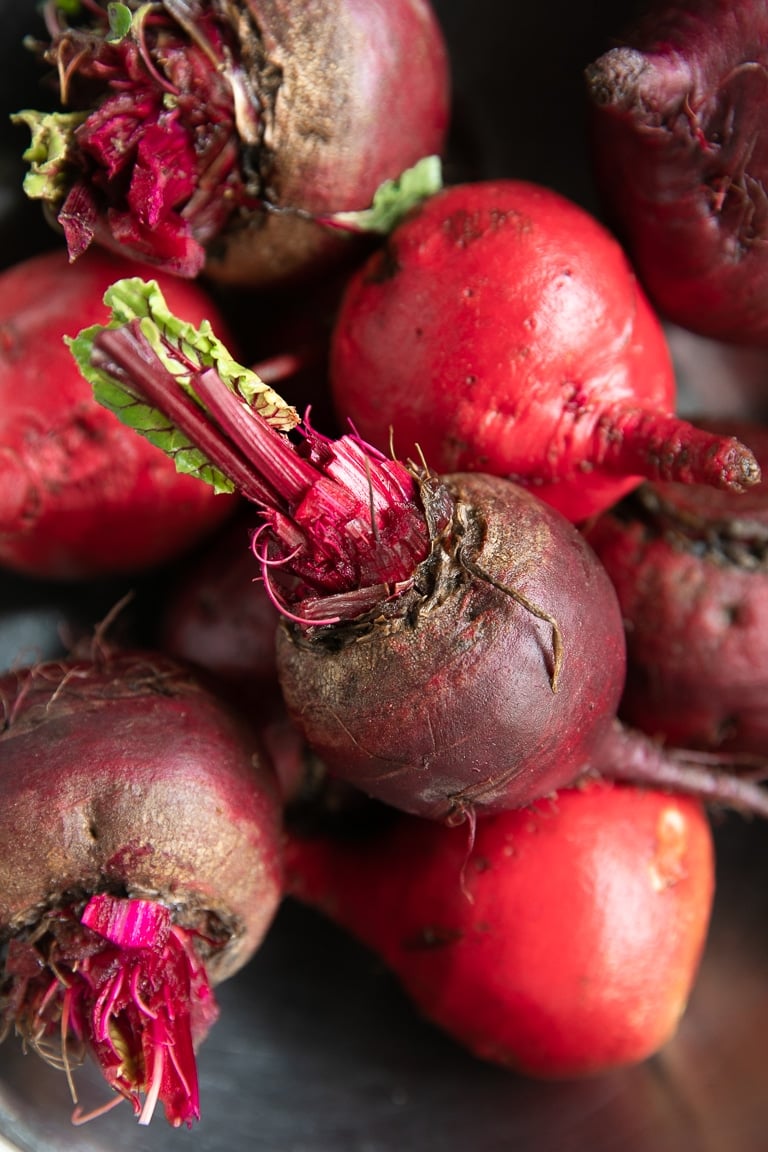
How to Cook Beets Recipe
Instructions
Boiled Beets
- Chop off the beet greens, leaving approximately 1-inch of the green intact. Wash and scrub the dirt from each beet.
- Add beets to a large pot and fill with water. Bring to a boil and then reduce to a simmer. Cook beets until fork tender, approximately 30-45 minutes. Carefully transfer beets to an ice water bath to stop cooking. Once cool, peel away the skin and rinse under cool water.
Steamed Beets
- Chop off the beet greens, leaving approximately 1-inch of the green intact. Wash and scrub the dirt from each beet.
- Insert steamer basket into a large pot and add just enough water so that the level remains below the steamer basket. Add the beets to the pot, cover with a tight-fitting lid, and bring water to a boil. Reduce heat and simmer until the beets are fork tender, approximately 30-45 minutes. Remove beets and allow them to cool before peeling and rinsing under cool water.
Roasted Beets
- Preheat oven to 425 degrees F. and set oven rack to the center position. Chop off the beet greens, leaving approximately 1-inch of the green intact. Wash and scrub the dirt from each beet.
- Place each beet in a piece of foil large enough to fully wrap up the beet and drizzle with approximately 1/2 teaspoon olive oil. Wrap each beet tightly in foil and transfer to a large baking sheet. Roast for approximately 45-60 minutes, or until fork tender. Remove beets from the foil and allow them to cool before peeling.
Notes
Nutrition
Nutrition information is automatically calculated, so should only be used as an approximation.
This post was originally published in April 2017 and updated in February 2019 with updated images and text.
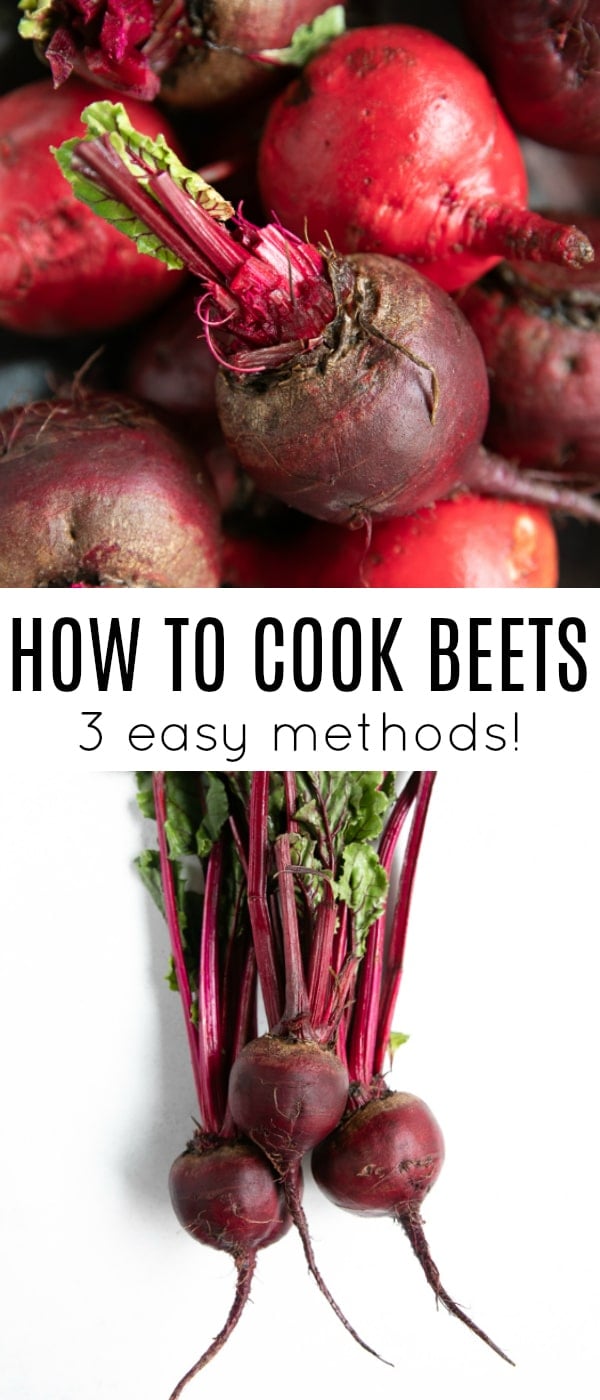
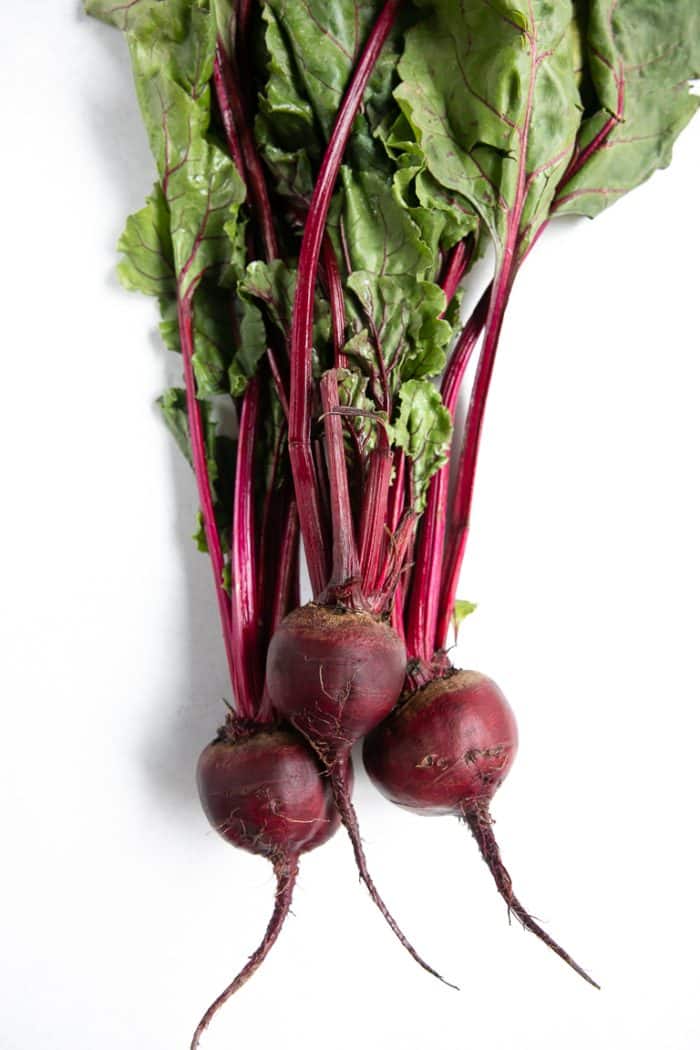

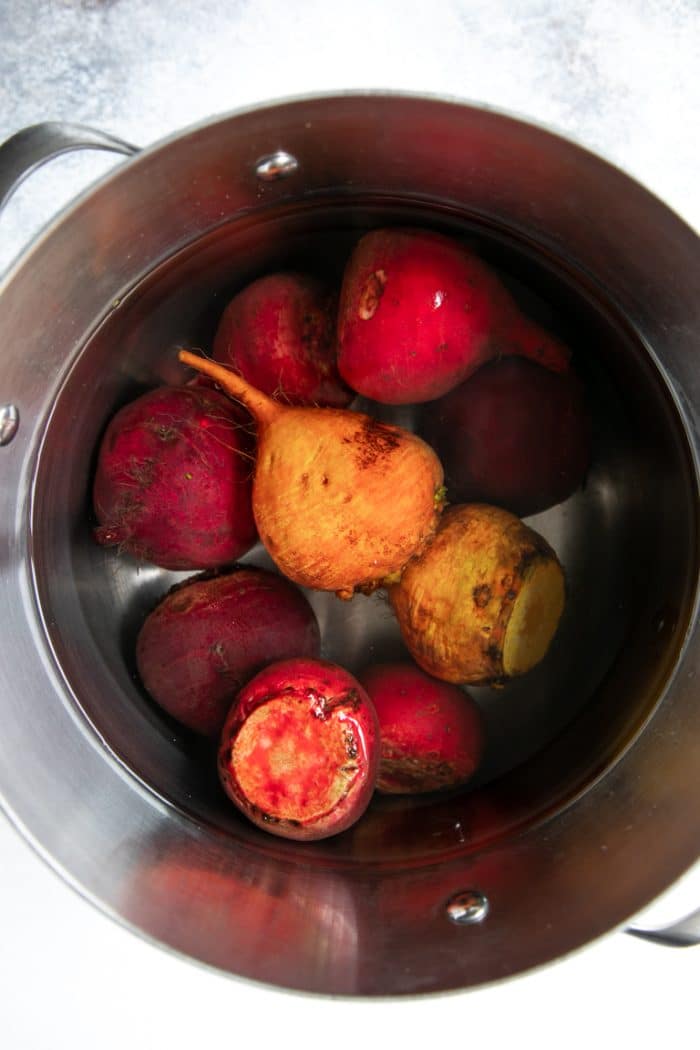
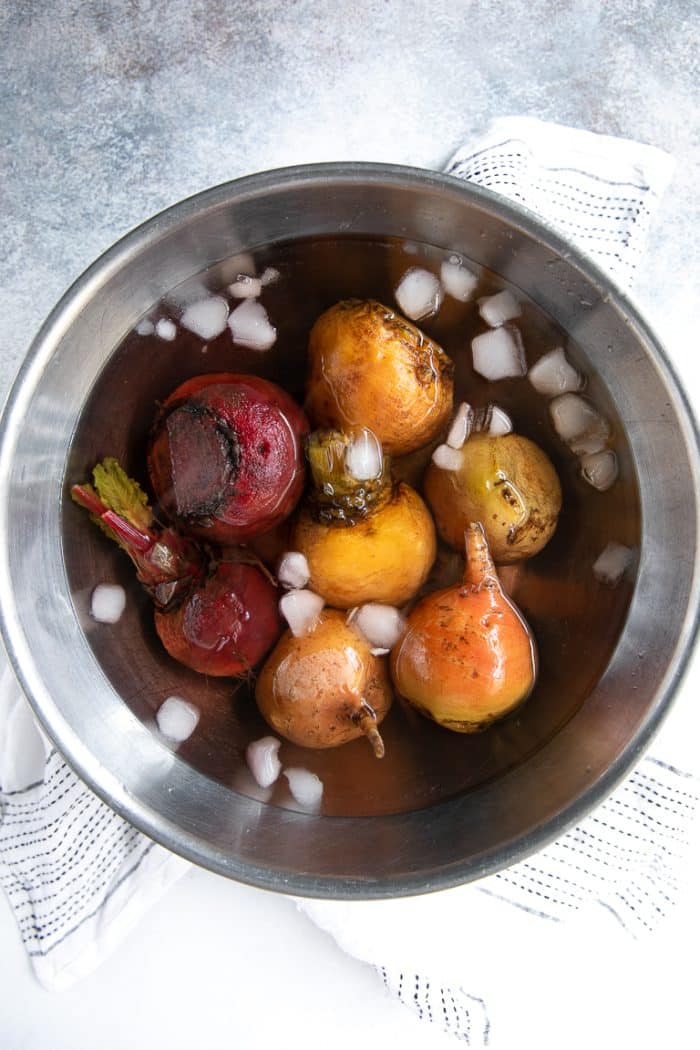
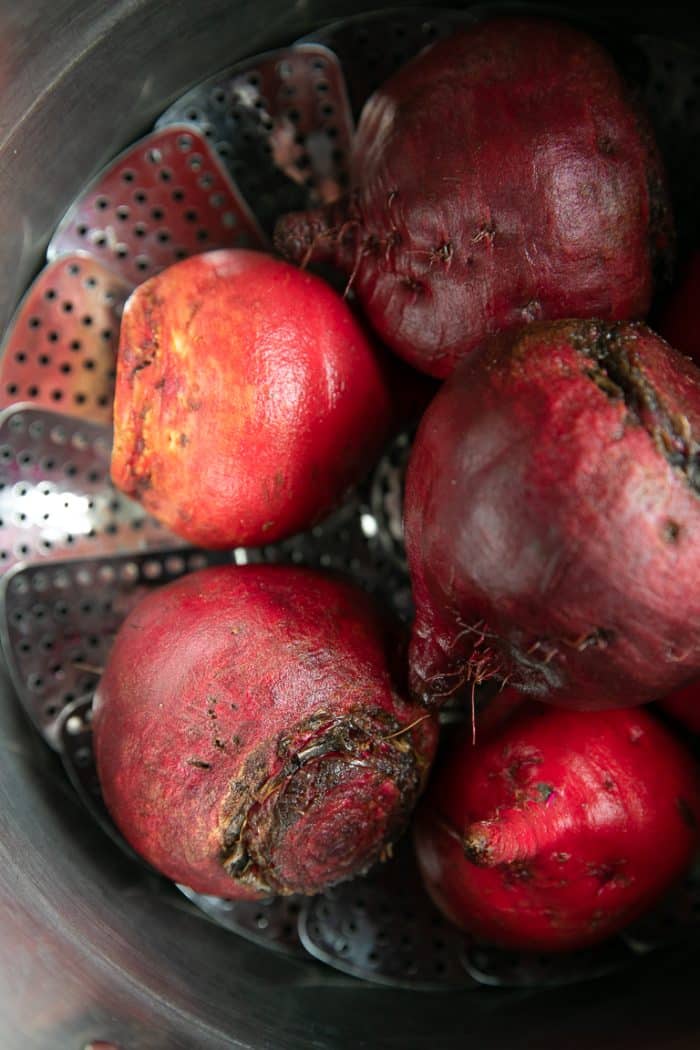
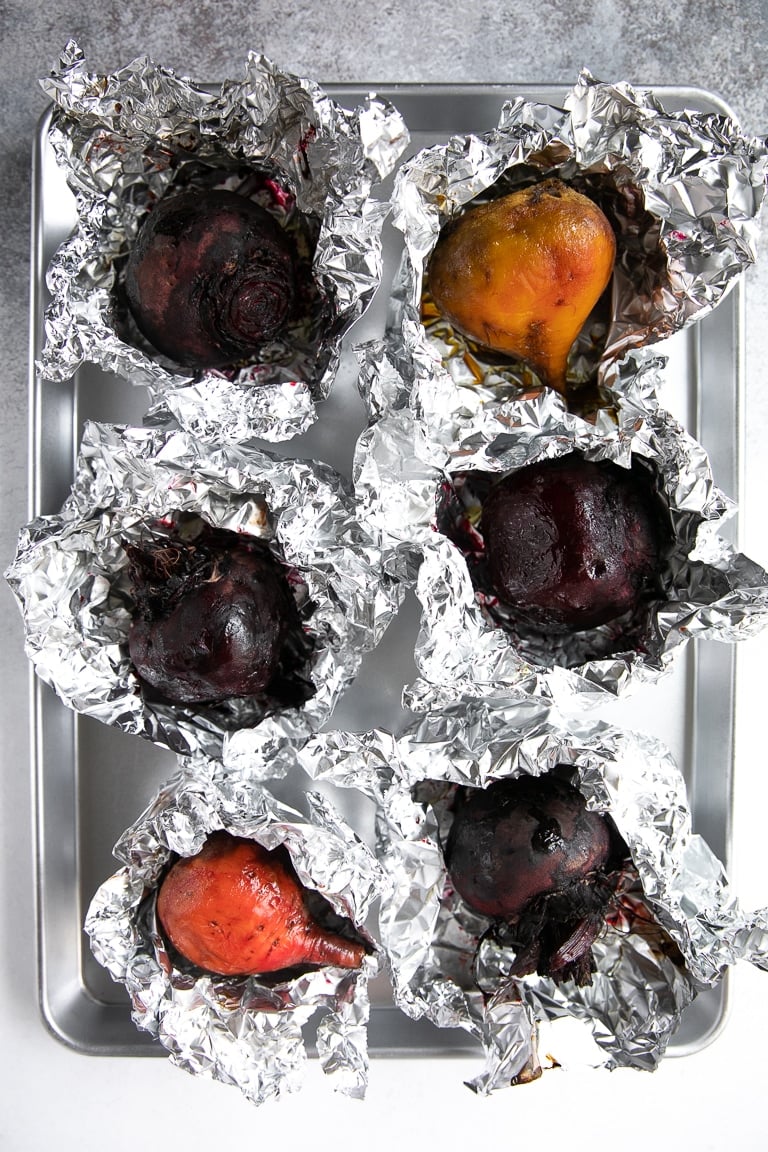
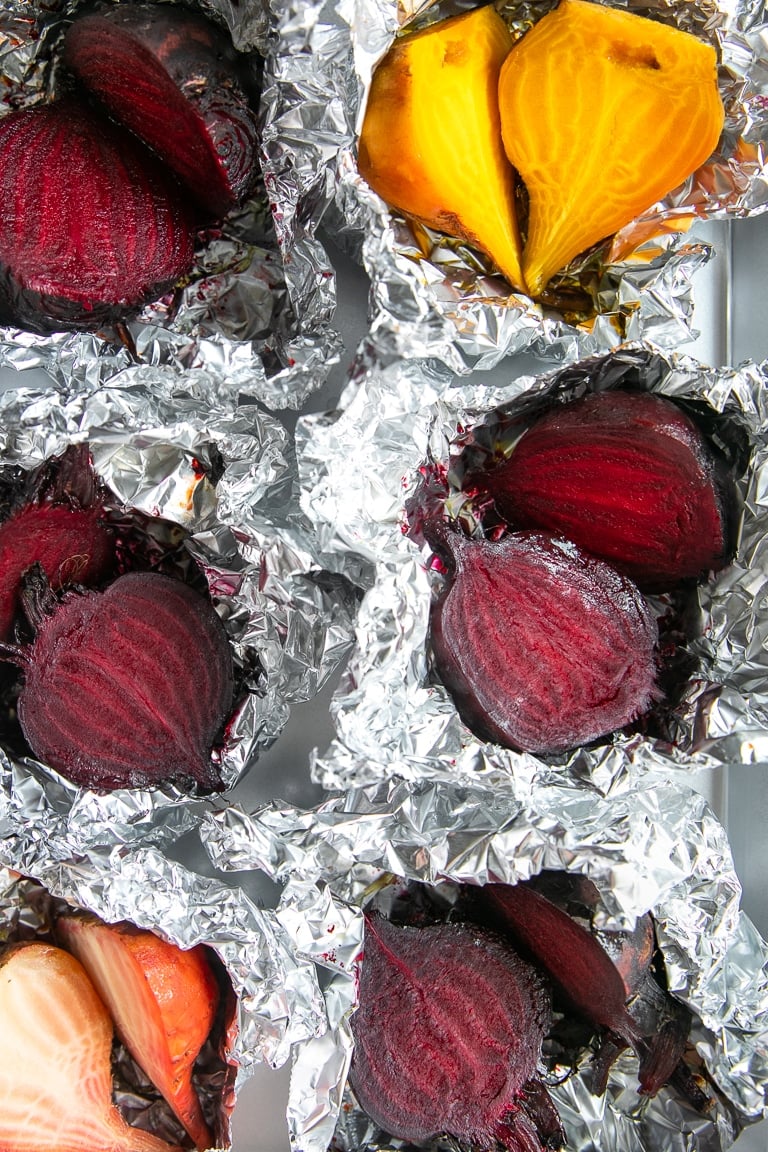














I’m an old 82 Year Old who has loved beets all my life, One complaint, when my dear old mum passed at 90, she forgot to tell us her recipe, which contained SUGAR?’
Love beets but lately caned beets have a weird taste so I’m going to steem my beets because I want to retain all the goodness.
Mom used to cook beets when I was a kid and I always love them! She canned beets in the summer and pickled them!! Love beets any way you fix them!!❤️
Guessing that’s feta on the beets in the photo. Please include text when appropriate.
Yes, that is feta and olive oil on cooked beets in that last image – the alt text of the image has been updated to reflect that for screen readers.
How do you cook the beets after they cooked do you add salt or anything else
I love adding cooked beets to all of my salads. When I eat them outside of salads, salt+pepper with olive oil to taste and add some feta for cheesy protein 🙂
Eww. Nobody else needed that to be pointed out. So tired of seeing jerks on free recipe sites.
Jessica: A big advantage to steaming or boiling beets is that you don’t have to use aluminum foil: A big ecological problem for landfills. Thanks for considering that in your next post.
Sarah
Aluminum also leaches into the food which is thought to aid in some of our present day illnesses.
My mother used to cook and peel and slice them, then added salt and pepper and vinegar. Then when ready to serve as a side dish added some olive oil.
What do you guys do with the leftover water? Do you dump it, or use it for other things? This is my first time making beets.
I Save the juice and put it in my shaker for protein powder mix the next day. Or drink with my supper.
I was looking for a time frame- I cube mine so steaming is faster
An extra way to stretch your beets:
I always buy my beets with the leafs attached (most of the time I buy organic). I cut 1” off the end where the leafs are, not much at all. I then cut off all the stems, about a 1/4” left on the beet cutting (I use the leaves for smoothies n salad, no stems, they can be bitter). Then Place the beets in a glass shallow bowl in a window with just enough water to cover the edge of where you cut. Change the water everyday or other day. Before you know it you’ll see leaves starting to grow! Once the leaves are about 1/2-1” tall place the beet in good soil outside. I place onto the soil and just barely cover edges with soil. You’ll have beet leafs to use whenever you need them for salads, smoothies, too sauté, etc.
I have at least 6 growing in y veggie garden all the time. And some people will say you can’t grow a beet from a cutting, well I beg to differ! It’s by no means a quick grow, but remember I have the beets in the soil for its leafs. But , in about 8 months a better bet will grow ABOVE grown!! I will go out to the garden and take a pic n attach it. (I don’t walk well due to MS so I can’t run outside to show you, though I pray I could!😆). But I will get one for you.
Thank you Jojo,i have leant how to regrow my beets,
i pray you get healed of MS soon.
blessings.
Thank you! My husband loves beets and instead of buying canned ones I’m going to try “fresh” and save the leaves as you have suggested! I pray all is well with you and take care!
If you’ve been having canned beets all your life, going to fresh will blow your mind. the flavour difference is truly wonderful
Hi Jessica,
Im trying to cook fresh beets for the first time.
Im making a pot roast in a slow cooker for 8 hours and was wondering if I could cook the beets in there along with the other veggies? Or will it turn my broth red and over power the taste.
Am I better off cooking them seperately?
Thanks you
Gina
Hi Gina,
The beets will absolutely turn your broth red, and it will make it much more earthy and slightly sweeter.
If you have not had fresh beets before, I would definitely cook them separately if you are not familiar with the taste of beets 🙂
why do you suggest discarding the greens? they’re delicious and nutritious! just saying….
I personally discard them to the compost, they’re usually pretty ratty and eaten up by the time my beats are big enough to eat. So that’s one good reason.